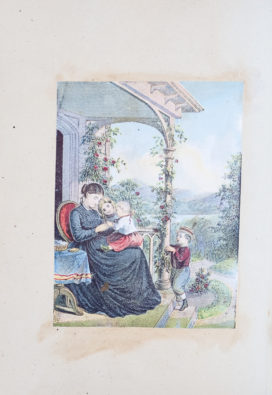by Janis M. Horne
One of the treasures in the Octagon House’s archives is a very fragile 150-year old scrapbook that belonged to Emma Eliza McElroy, the daughter of its original owners.
This fascinating Victorian woman’s scrapbook contains, among other things, sentimental illustrations, pressed flowers and leaves commemorating various outings, and newspaper clippings of all kinds dating from 1869 to at least 1888. There are morally uplifting poems, essays and anecdotes, humorous items, news stories, obituaries, and even an occasional cartoon or recipe. The scrapbook provides a tantalizing glimpse into San Francisco’s Victorian culture and the life of its owner as she moved from being a young single schoolteacher to a married woman to a widow after a tragically short five years of marriage.
The scrapbook’s slowly disintegrating condition prevents it from being physically shared with the public. Now, however, thanks to advances in digital technology and some beautiful photography by Marian Bliss, you can view the entire contents of Emma Eliza McElroy’s scrapbook by clicking here. Use the “zoom in” feature on your computer to enlarge the photographs to make the items on each page of the scrapbook easier to see.
 Emma’s Eliza McElroy’s Scrapbook
Emma’s Eliza McElroy’s Scrapbook
Below are the answers to some frequently asked questions about Emma Eliza McElroy and her scrapbook:
Why Did Emma Decide to Keep a Scrapbook?
Scrapbooking was a very popular Victorian woman’s pastime during the second half of the nineteenth century. It was a creative way to record memories of special events and to preserve items of all kinds that the owner likely found to be personally meaningful, interesting, informative, amusing, aesthetically pleasing or morally or emotionally fulfilling. Scrapbooks could also be used to store the results of another popular Victorian hobby – the pressing of flowers, leaves and similar materials to dry and preserve them with some original colors still intact.
More specifically, we know from her signature and date at the front of the scrapbook that in January of 1870, a little over one month after her father William McElroy’s death, an 18-year old Emma likely started pasting items in her scrapbook. Her father’s obituaries are the first items on the first page of the scrapbook. (The oldest datable items in the scrapbook are generally from the latter part of 1869, shortly before her father’s death.) So starting the scrapbook might have been a “coming of age” activity for Emma. She may also have been motivated in part by memories of the time capsule her father had created in 1861 by putting newspaper clippings, a family photograph and a letter “to future ages” in a tin canister that, along with a cache of newspapers, was hidden in the Octagon House for someone in the future to discover. Whatever the specific reason, we know that Emma would continue pasting items in her scrapbook for at least the next 18 years – until shortly before her marriage to her second husband.
Are the Items in the Scrapbook in any Particular Order?
No, there does not appear to be any particular rhyme or reason as to where items are placed in the scrapbook. Many of the items are not dated and the datable items are not in chronological order. There is a group of obituaries (including her father’s) on the first page of the scrapbook, but some of the oldest newspaper clippings are found at the back.
What Else Do We Know about Emma Eliza McElroy’s Life?
Emma was probably born in New York. She was likely adopted by her parents William and Harriet McElroy sometime after their marriage in 1859 and before the 1860 census, when Emma was listed as living with them in San Francisco. The 1861 time capsule photograph of Emma at age 9 is the only known record of what she looked like. All available evidence suggests William and Harriet McElroy loved and treated Emma just as if she had been their own natural daughter.
Emma grew up in the Octagon House hearing fascinating stories from her parents (and particularly from her mother) about what life was like in San Francisco during the heady days of the California Gold Rush. She continued to live in the Octagon House with her mother after the 1869 death of her father. During her years as a single woman, Emma became a teacher and perhaps even an Assistant Principal at San Francisco’s Broadway Primary School.
In 1879, she began dating her future first husband, grocer-merchant Samuel Tallman. Their 1882 San Francisco wedding was followed by a honeymoon in Monterey, California. It is possible that the couple then lived in the Octagon House with Emma’s mother. Sadly, after only five years of marriage, Samuel Tallman died of typhoid pneumonia in 1887.
Emma married her second husband, attorney Abraham P. Van Duzer, two years later. They would live in his house on Guerrerro Street in San Francisco.
Interestingly enough, both of Emma’s husbands were Ohio natives who had been widowers before they married her.
In 1898 (the year before she died), Harriet McElroy deeded the title of the Octagon House to Emma “in consideration of the Love and affection which the first party bears to the second party, and for her better maintenance, support, protection and livelihood.” Emma rented the house to several different tenants, including the family that was living it when the home was badly damaged during the great San Francisco earthquake of 1906. After repairing the earthquake damage, Emma continued renting out the Octagon House until her death in 1909. Since Emma never had any children (or at least any surviving children) of her own, she bequeathed the Octagon House to her step-daughter Kate Van Duzer.






